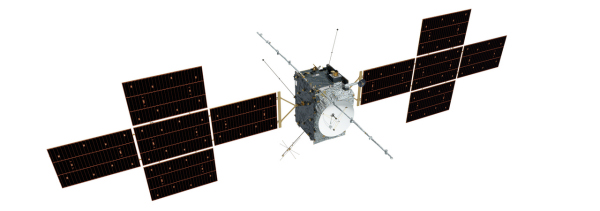Spacecraft
The main spacecraft design drivers are related to the large distance to the Sun, the use of solar power generation, and Jupiter's harsh radiation environment.
 |
| Artist's impression of the JUICE spacecraft, as of July 2017. Credit: ESA/ATG medialab |
The orbit insertions at Jupiter and Ganymede and the large number of flyby manoeuvres (more than 25 gravity assists and flybys) requires the spacecraft to carry about 3000 kg of chemical propellant.
The large distance to Earth results in a signal round trip time of up to
Payload accommodation would take into account the need for radiation shielding and satisfy requirements from individual instruments. The JUICE mission focuses on Ganymede and Callisto, along with two Europa flybys, and therefore stays outside of Jupiter's main radiation belts for most of the mission operations. This means that shielding can be used as the primary protection for the onboard electronics.
The use of solar array power generation in combination with the large distance from the Sun, with a worst-case solar constant of 46 Wm-2, results in large area solar arrays, of typically about 60 – 75 m2. Since the radiation environment is dominated by electrons, solar arrays can be used to provide electrical power, with GaAs solar cells optimized for 'Low-Intensity/Low-Temperature' conditions.
 |
| Earlier JUICE design studies. Credit: ESA |
The JUICE mission includes a number of flybys of the Jovian moons Callisto, Ganymede and Europa, all of which are subject to varying degrees of planetary protection. This has implications for the design and integration activities of the spacecraft and payload. (See the COSPAR report on Planetary Protection for further details.)
(For more detailed information about the JUICE spacecraft design, please consult the JUICE assessment study report (Yellow Book) - see link in right-hand menu.)
